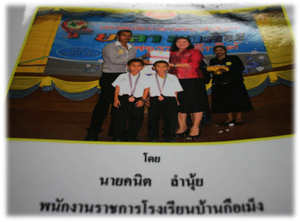The Herculean task of protecting teachers against militant attacks
 YALA - The exhibition booths set up in the compound of Ban Kor Meng school in Tambon Arsong, Raman district by the Dong Tarn group on September 7 as part of a seminar titled “Yala Yalan, the Amazing Southern Border” were virtually empty as most of the students left to attend the funeral of their fallen teacher at a temple in the district.
YALA - The exhibition booths set up in the compound of Ban Kor Meng school in Tambon Arsong, Raman district by the Dong Tarn group on September 7 as part of a seminar titled “Yala Yalan, the Amazing Southern Border” were virtually empty as most of the students left to attend the funeral of their fallen teacher at a temple in the district.
Mr Kanit Lamnui, 38, was shot dead one day earlier as he was riding home from school. His assailants, riding two motorcycles, gave pursuit and one of them, the shooter, pumped four 9mm shots into his body, killing him instantly. Then the assailants poured gasoline on his body and set it afire.
Mr Kanit became the latest teacher gunned down by suspected militants. More than 150 Thai and Malay Muslim teachers and educational officials have so far been killed for the past seven years since January 4, 2004. Many others were injured. In August, two teachers were shot dead in Pattani and another was seriously injured allegedly by suspected militants.
A native of Raman district, Mr Kanit graduated with a Bachelor’s degree majoring in English from Ratchabhat University’s Yala campus 2002 and started his teaching career at Ban Kor Meng school after the graduation. Two years afterward, he was made a permanent staff. He was named an outstanding teacher this year but was yet to receive the award.
Speaking on the condition of anonymity, a security officer said that ensuring the safety of teachers in the three southernmost provinces had been given top priority but, however, there are still loopholes in the security net. He maintained that most of the teachers who were killed or injured by suspected militants were not covered by the security net because they traveled alone unescorted.
The latest victim, Mr Kanit, travelled alone when he was attacked.
Teachers have been a target of choice by the militants because they are “soft” target and also because the attacks against them often cause public uproar and attract widespread media attention, said the officer. As such, protection to ensure safety for the teachers has been a top priority, he added.
Normally, teachers are traveling in a convoy from a specific meeting points to their schools. The convoy is guarded by troops. Before the start of the dangerous journey each day, an advance patrol unit either on foot or riding on motorcycles will survey the route first. The advance unit will look out for suspicious things which may suggest that a bomb is buried under the road or whether militants are hiding in the bushes beside the road waiting for an ambush. When the route is clear, then the convoy will start the journey. And this has been the routine ritual from the meeting point to schools in the morning and vice versa when classes are closed.
The officer pointed out that most of the escorted convoys for teachers were not attacked by the militants. In most cases, it was the advance patrol units which bore the brunt and were targeted by the militants, he added.
Despite the tight security, there are lapses in the security net. The convoy often uses the same route on daily basis simply because it is the only route available in the village. Also, most of the village routes or roads are narrow and their roadsides are often covered with thick bushes providing ideal cover for the militants.
The security officer further said that some teachers did not want to be protected and chose to travel among themselves in groups believing that it is safer to be unescorted by security forces. Other teachers do not want protection because they are local people or because they live not far away from schools.
Another security lapse, said the officer, is that the militants appear to have access to information about the movements of the teachers and their security guards because they are spies among the villagers whereas the government forces have little information about the movements of the militants.
-----------------------------------------------------------------------------------------------------------------
Photo by Amad Ramansiriwong
